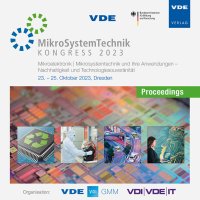Self-Sensing of Piezoelectric Actuators: Integrated Bubble Detection for Reliable Drug Dosing
Conference: MikroSystemTechnik Kongress 2023 - Kongress
10/23/2023 - 10/25/2023 at Dresden, Deutschland
Proceedings: MikroSystemTechnik Kongress 2023
Pages: 7Language: englishTyp: PDF
Authors:
Axelsson, Kristjan; bin Tariq, Arham; Zerbib, Gabriel; Richter, Martin; Kutter, Christoph (Fraunhofer Institute for Electronic Microsystems and Solid State Technologies EMFT, Munich, Germany)
Abstract:
When administering drugs with microdosing systems based on piezoelectric micropumps, disturbances such as small bubbles or blockages can lead to large dosing errors. Bubble and pressure sensors are used for error detection to ensure safety and dosing accuracy. Due to regulations in medical technology, sensors that come into with patients or medi-cations cannot be reused. This results in higher costs and increased system complexity. A radically new approach is taken to detect bubbles during operation of the piezoelectrically driven micropump . Bubble detection is achieved without additional sensors and without modifying the micropump, simply by analyzing the drive signal. Classical piezoelectric micropumps use the indirect piezoelectric effect to cause a mechanical deflection by applying a voltage. In contrast, piezoelectric sensors use the direct piezoelectric effect to obtain an electrical signal from a mechanical deformation. We propose to use not only the indirect piezoelectric effect for actuation, but also simultaneously the direct piezoelectric effect as a sensor signal so called self-sensing signal. The fluid-mechanical couplings of the system modulate the charging current of the piezoelectric ceramic in a variety of ways so that diverse system states produce a charac-teristic "fingerprint" in the self-sensing signal. The measurement is realized by a current-to-voltage-converter circuit. This amplifier circuit measures both signal components, consisting of charging current of the piezoceramic and the self-sensing signal. The drive signal of the piezoceramic is not influenced by the self-sensing circuit. For efficient use of the self-sensing signal, the driver circuit of the piezoelectric pump is extended by artificial intelligence methods (AI methods) in addition to a new measurement circuit. For an application-oriented use of the self-sensing property, the AI methods are trained with characteristic measurement data. This training data is generated at a specially designed testbench. In this way, various fault conditions such as viscosity changes, bubbles, changes in system pressures, clogging and electronic faults can be simulated and clearly assigned to the measured self-sensing signal. In the first version, the algorithms are trained on the detection of different media and the detection of bubbles. The AI methods are trained on a performant computer, and then transferred to a microcontroller, the edge-device. With this approach the piezoelectric driven micropump detects bubbles without any additional sensors in real-time.


